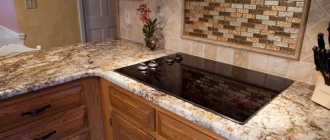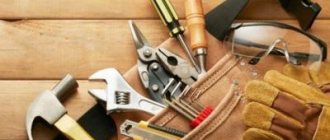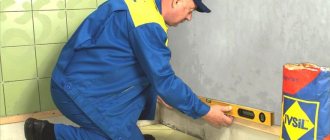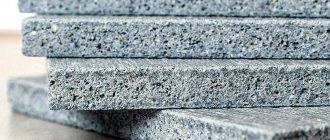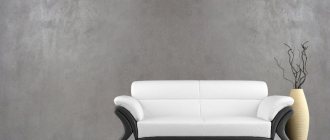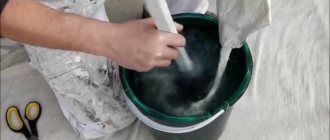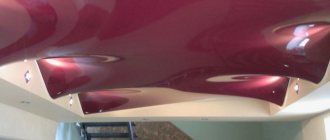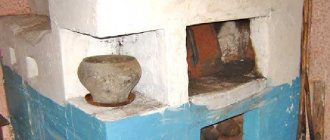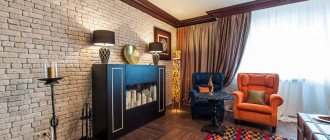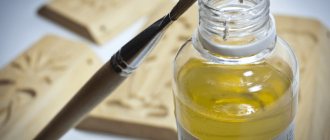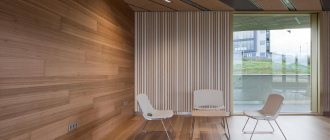Classification of mirror tiles
Depending on the material used in the production process, decorative elements are of the following types:
- glass - made by melting a mass of glass with mufflers and gaseous crystalline compounds;
- metal - the polishing method is used in production;
- plastic - panels are made of polyvinyl chloride or polystyrene by gluing a reflective film or applying paint with tiny particles of steel.
Decorative tiles made on the basis of PVC or metal are an imitation of mirror cladding, are lightweight, low cost, and flexible, but the reflectivity of the coating is worse than that of glass products.
Glass tiles are classified:
- by purpose: wall, floor, ceiling and universal;
- in shape: square, rectangular, mosaic (individual chips or modules), in the form of stripes, rhombus, triangle, circle and semicircle, hexagon;
- according to color scheme: the front side of the cladding can be bronze, gold, silver, blue, pink, green. In addition, the tile can be plain or with an ornament or pattern applied to it using thermal printing or sandblasting;
- surfaces vary according to the processing method: polished, glossy or matte;
- according to the method of edge processing: with or without bevel.
Installation of mirror cladding is identical to the process of laying ceramic tiles, but there are products that do not require the use of adhesives. This tile has a thickness of 4-6 mm, consists of an outer (reflective) surface and an inner (adhesive) layer, covered with a protective film, which must be removed before work.
Panel based on a mirror photo collage
One of the most unusual types of mirror panels is a panel with photo printing applied to them. The manufacture of such mirrors is considered one of the most difficult, since transferring an image onto a smooth surface requires extreme precision and accuracy.
But the panel immediately turns into a stylish decoration; such a composition can be compared to an ordinary picture on the wall. The light reflected from the surface shines through the layer of paint and the image seems to come to life. A mirror panel with a photo collage gives the room a special exclusivity.
Panel with a complex photographic sandblasted pattern and tonal varnish treatment
Modern sandblasting technologies make it possible to apply almost any photo quality design to the mirror. The only downside is that it won't be a multi-color image. Just as in the case of ordinary tile panels, you can get creative with the frame. In the example, the smooth boundaries of the figured mirror echo the same uneven boundaries of the granite frame. Such curved boundaries are obtained using the hydrojet cutting method.
Painting on a mirror framed by a granite frame
Advantages and disadvantages
The advantages of the products include:
- moisture resistance, which allows the cladding to be used in rooms with high humidity levels;
- long service life, subject to compliance with installation technology and maintenance rules;
- fire safety (glass and metal products are not subject to combustion) and environmental friendliness;
- resistance to aggressive chemicals, easy to maintain.
- the material is subject to darkening, which can be prevented by organizing ventilation in the room or regularly ventilating the room;
- The facing elements are fragile; chips may form on the edges during transportation and installation.
How to glue mirror tiles?
The main condition for high-quality work is the evenness of the base.
Preparing the base
- remove old wallpaper, tiles, glue residues, plaster. Inspect the base: if there are minor defects, level the surface with plaster. In case of large differences in heights, fix sheets of plasterboard on the walls, check the evenness of the surface with a level and plumb line;
- apply primer mixture. When renovating a bathroom or kitchen, use a moisture-resistant composition;
- draw vertical marking lines: it is advisable to place a solid element near the ceiling;
- Mark the horizontal line around the perimeter of the walls, taking into account the seams. Check the markings with a level;
- if glass tiles will be used during the installation process, install the support rail under the start line of the first row and start work from this mark.
Preparing the adhesive mixture
Glue containing additives in the form of acidic oxides is not suitable for mirror cladding.
Glass products are fixed to the walls using a special tile adhesive intended for mounting mirrors, or other chemically neutral mixtures based on epoxy resins, silicone sealant, liquid nails:
- Installation moment - a moisture-resistant composition containing synthetic resins, suitable for fastening mirror tiles indoors, has good adhesion and resistance to vertical shifts, and is elastic;
- Titan Professional - adhesive based on synthetic rubber and resins, suitable for work on horizontal and vertical surfaces, moisture resistant;
- When installing with liquid nails, make additional fixation before installing the tiles using double tape glued to the back side.
Laying tiles
- start work from the farthest corner of the room (when covering the entire surface of the wall), laying out rows from the floor to the ceiling;
- Apply a small layer of adhesive with a notched trowel onto the back surface of the cladding, wait a while (2-3 minutes) and carefully place the tile on the base, press lightly with your hand;
- install the remaining products by inserting dividing crosses into the gaps between adjacent elements;
- Having laid several rows, remove excess glue with a sponge or damp cloth;
- cut the products with a diamond glass cutter with oil, be careful in the process: first draw a line on the surface, then run the tool along it, leaving a scratch mark, then cut the material with strong pressure;
- one day after finishing the work, grout the joints with a rubber spatula: use the composition used for installation for this purpose, you can also use neutral silicone sealant (gray or transparent);
- After 5-6 hours, wash the finished coating.
Laying tiles
As we have already noted, this material is quite delicate, so it is not recommended to lay it without prior marking. The result obtained may be far from the desired one. mirror tiles so that the result harmoniously complements the interior?
To do this, we suggest that you divide all the work into several stages:
- Marking the surface for laying tiles. In order for the picture to come out perfect, you should first lay out the desired pattern on the floor, on a flat surface. Then carefully mark the wall or ceiling along this blank. It is important to approach this stage responsibly, without unnecessary haste.
- Laying tiles. After you have prepared the base well, chosen the right glue and outlined the future pattern, let's get started. You need to start from the bottom and glue along horizontal rows. It is very important not to deviate from the markings.
If there are temperature changes in the room, it is better to leave a small gap between the tiles. This will protect the mirror coating from deformation and cracks in the future. To ensure uniform seams, use special crosses. They will ensure the step you have in mind.
Directly during installation, it is better to store the product not in stacks, but vertically. This will protect the sensitive coating from.
- Apply glue. If you plan to glue it with a special mixture or sealant, then there should be no problems. The covering elements are attached well and do not slip. The adhesive base (mixture, sealant, liquid nails) is applied directly to the tile, which is then applied to the desired location and pressed down for a few seconds. It is worth noting that liquid nails are not suitable for laying over a large area, as the rows can creep one on top of another. To prevent this from happening, secure each tile with tape.
Video on how to glue mirror tiles:
If the need arises, it is best to use a diamond glass cutter for this. Then the edges will be smooth, without unnecessary chips.
- . After you have laid out the entire surface, you need to let it harden well. This often takes several days. If you left seams, they must be closed in order to protect the tiles from moisture and give it an aesthetic appearance. Neutral transparent silicone will cope best with this task. Apply it using a special gun, and then remove the excess with a damp cloth or a special non-metallic spatula.
By following these guidelines, you can install mirror tiles yourself, decorating the interior with an elegant and beautiful decorative element.
A variety of modern finishing materials allow you to embody the most daring design ideas. One of the most convenient finishing materials, which has recently become increasingly popular as a universal decorative element, is mirror tiles.
Mirror tiles are an excellent material that will eliminate the shortcomings of repairs and visually enlarge the room. Mirror tiles are used for almost any room: in the bathroom, in the hallway, in the bedroom, for suspended ceilings. Mirror tiles have a lot of advantages, thanks to which they stand out among other finishing materials for decoration.
Advantages:
High level of light reflection; . Resistance to external influences: indoor humidity, use of chemicals; . Versatility and a wide range of products for any interior; . Practicality (ease of care)
Mirror tiles are presented in a wide range that can satisfy any consumer taste. Mirror tiles come in a variety of shapes, colors and sizes. The main dimensions of mirror tiles: small size - 292x295 mm, large size - 1195x1995 mm.
If you decide to add some variety to your interior or eliminate existing repair defects, or simply want to visually expand and brighten the room, then your choice is mirror tiles. Mirror tiles are easy to lay on your own, without resorting to the services of professionals. The process of laying mirror tiles
1. First of all, prepare the surface
The surface for laying tiles must be perfectly flat and free of any flaws. If necessary, remove the plaster from the surface down to the concrete or brick. Then level the surface with putty. Finally, prime the surface with a primer and let dry.
2. Mark the surface for laying tiles
It is imperative to apply markings to the finished surface in order to lay the rows of tiles perfectly evenly. When determining the markings, take into account the actual dimensions of the tiles so that there is no bevel. In the case of laying a panel of mirror tiles, first select all the tiles for the future panel and lay it out on the floor. Only after this can you transfer the panel directly to the surface.
3. Start laying tiles
Remember that laying tiles must begin with a horizontal row. The installation scheme is simple. First, take one tile, apply a specially selected adhesive mixture to the inner surface, then apply the tile to the surface and press it with your hands. Be careful not to damage the tiles. As soon as the tiles are glued, place a cross on the border (purchased at a special store, which is used to determine the thickness of the seam between the tiles). Then you continue in the same order. If you plan to lay out a large panel, break the work into several stages.
4. Grout the joints
Only after all the tiles have been laid, let them dry for several days. Only after the glue has completely dried can you start grouting the joints. For this, a special neutral silicone (transparent) is used, which is absolutely invisible on the surface. To do this, prepare a glue gun and silicone. Using a gun, squeeze a small amount of silicone into the seams. Excess silicone must be wiped off immediately with a damp sponge. After the silicone has completely hardened, rub the tiles with a cotton cloth until glossy.
To order installation of mirror tiles from specialists, create a task on the YouDo website. After publishing your application, craftsmen who are ready to begin laying mirror tiles will contact you. All that remains is to choose a professional whose working conditions completely suit you. Discuss the details of the order (dates, price) with the YouDo contractor and agree on the time of his visit.
Using mirror tiles
Bathroom finishing
In most cases, bathrooms do not have windows, which requires the presence of light sources when present in the room. You can visually increase the dimensions and improve the illumination of the room by using mirror cladding in the interior.
Decorative products must be designed for use in conditions of high humidity, otherwise the coating will fade or begin to blacken.
A bathroom ceiling lined with mirror tiles will visually increase the space. A coating that combines the design of its central part with glossy cladding and placement of tiles decorated with ornaments around the perimeter will look beautiful.
If the dimensions of the room are large, you can additionally decorate pieces of furniture (cabinet doors and shower stalls) with tiles.
If desired, individual fragments of the cladding are decorated by applying designs with acrylic or stained glass paints.
Kitchen finishing
A reflective coating can not only visually change the size of a room, but also its shape, which is especially important for oblong kitchens. It is advisable that there is a window opposite the cladding - this will fill the room with light.
A beautiful design solution would be to decorate the wall with a combined coating of mirror and ceramic tiles of the same format.
The manufacture of furniture facades is also possible using glass reflective surfaces.
DIY mirror tile panel (video)
Nothing complicated or impossible! Maximum attention and very soon a fashionable panel will decorate a once boring wall or furniture and become a full-fledged and original element of the interior!
What is the role of such a panel in the interior? It's simple - it changes the boundaries of perception of the room, which is filled with excess light. More precisely, not superfluous, but very necessary. After all, the main thing that should be in a modern interior, if you listen to the designer, is space and light.
Features of working with ceiling tiles
- Before laying on a wooden surface, be sure to treat the base with an antiseptic compound and primer;
- it is easier and more convenient to fix the cladding onto a plasterboard frame: leveling the ceiling with putty will lead to higher costs of work and greater labor costs;
- installation is carried out in two ways: with screws or gluing. When laying on drywall, adhesive must be applied around the perimeter and in the center of the tile. Fixation with screws requires complex drilling of elements, which is associated with the risk of damage to the material.
Compositions for application
It is best to use any neutral sealant as glue. You can use Liquid Nails LN-930 Mirrors, but this composition is inconvenient to work with large volumes because it takes a long time to set.
For grouting joints, it is recommended to use neutral sealants of any color. The most commonly used sealant is dark gray - it does not create a contrast with the mirror tile itself and has bactericidal and antifungal properties, which is important for rooms with high humidity.
When laying with a neutral sealant, the seams can be grouted within 1-2 days. Tiles laid on “Liquid Nails” LN-930 Mirrors, it is advisable to grout the joints after 4-5 days. Using a neutral sealant has another advantage - mirror tiles are glued and grouted with the same compound. Thus, less waste is generated after the work is completed.
To quickly clean the tiles from sealant residues after grouting, we recommend two technologies to choose from:
- Before laying the tiles, cover the perimeter of each tile with masking tape;
- After laying the tiles, apply masking tape directly to the seam, and then use a knife with replaceable blades to cut the seam, which will be filled with sealant. These technologies ensure maximum accuracy and speed of work.
Interior with mirror tiles
The ability to visually expand the dimensions is relevant for an elongated room: placing the tiles on a long wall will correct such disproportion.
You can achieve a simultaneous visual increase in width and height of a room by laying elements on one wall diagonally or in diamond shapes.
To avoid the “labyrinth” effect, it is not recommended to place mirror surfaces opposite each other.
Covering the entire surface of the ceiling of a large room with tiles creates a feeling of emptiness and coldness; in such cases, it is advisable to do the installation only in the center or perimeter with the arrangement of spotlights.
The desire to make an apartment or house cozy and bright can easily be realized with the help of mirror tiles. Refrain from covering too large areas: reflective elements can be irritating to the psyche and cause anxiety, therefore, when trying to create an original design, be careful and do not overuse the number of reflective surfaces.
Interior decoration
Mirror tiles can be used in almost any interior. It is convenient to apply to a wide variety of materials: plastic, metal, ceramics, etc. But when using this decorative element you need to know a sense of proportion. A large number of mirrors and stained glass windows in a room negatively affect a person’s psychological state.
You can use mirror tiles only on two adjacent surfaces, for example, on the ceiling and one of the walls, but in this case it is better to take materials with different textures or patterns. It is not worth covering the ceiling completely with mirrors, because... It may feel like the room is upside down. It is more expedient to decorate only part of the ceiling with this material.
To ensure that the light reflected on the surface of the mirrors does not tire the eyes of the beholder, it is better to use lamps with a soft matte glow or LEDs. You can use mirror tiles in any room of an apartment or private house.
Hallway interior
Reflective surfaces allow you to visually enlarge a small hallway and harmoniously decorate a large hall. If the apartment has a narrow, long corridor, then there is no need to decorate both walls with mirrors at once; you should limit yourself to only one plane.
In small hallways, you can line part of the wall with this material and hang lampshades above them. This will make the corridor visually more spacious and comfortable.
In the halls, mosaic tiles look great, effectively decorating one of the walls. Mirrors also look good in a hallway niche. A wardrobe is usually placed in it, but if there is no need to install it, this niche can be decorated with mirror tiles with ornaments or bright designs.
The tiles often depict:
- hieroglyphs;
- silhouettes of people, animals and birds;
- flowers;
- eastern ligature.
Living room design
Mirror tiles in the living room are often used to zone the room. Often it is used to highlight a fireplace or a sofa. In private homes, columns and niches are decorated with this material. The fireplace framed by a mirror mosaic looks very impressive. You can also make a stripe on the wall from this tile, placing flowers or floor lamps next to it. Thanks to this technique, it will seem that there is a lot of color and light in the living room.
This material is also used to decorate furniture. They can be used to lay out wall shelves or shelving facades. Moreover, mirror tiles will be appropriate in palace, urban, and oriental interiors.
A mosaic of mirrors is suitable for a kitsch-style interior, creating unusual multi-colored tints. You can decorate one of the living room walls with classic tiles, and then place a stylish sofa next to it. Its straight lines will look good against a mirror background.
Kitchen decoration
Mirror tiles in a post-Soviet kitchen look unexpected, although acceptable. This decorative item is not only beautiful, but also functional. It is ideal for classic small kitchens in typical homes. Mirror tiles can be used to decorate the kitchen apron. This tile can be decorated with interesting designs, ornaments or holography.
For kitchen sets in a classic style, aged mirror tiles are suitable. On such a surface, stains, drops of water and fat are almost invisible. This decorative material can be used to decorate the wall above the kitchen unit if there are no top drawers, or the wall next to which the dining group is located. This technique will help give a narrow and long kitchen a square shape. And, of course, you can decorate the facade of the kitchen unit with mirror tiles.
Bedroom design options
Mirror tiles in the bedroom make the room unusual and piquant. From this material you can make a completely monolithic wall or a mirror ceiling. But such an installation should not be placed directly opposite the window; the tiles will look much more impressive to the left or right of it.
If a wall decorated with mirror tiles reflects sources of artificial light, this can make the room brighter and more comfortable. But this finishing method is only suitable for large rooms. In small bedrooms, it would be more appropriate to decorate only part of the wall with mirror tiles, for example, the head of the bed.
The doors of wardrobes, bedside tables or chests of drawers for linen are often decorated with tiles, and beds are also decorated with mirror tiles, but this will not be appropriate in all interior styles.
In the children's room
The presence of a mirror wall in a children's room causes controversy among designers and psychologists. Of course, such tiles will look impressive and stylish, turning the nursery into a fairy-tale corner, but from a psychological point of view, this piece of furniture is inappropriate in rooms for small children.
A wall made of mirror mosaic can disrupt a child’s sense of reality, so this interior element is suitable only in rooms for teenagers. In other cases, you can hang a panel of mirror tiles on the wall or decorate the clock in the room with tiles. But such decor is not recommended to be placed in front of the child’s eyes: above the desk, opposite the bed or in the sports area next to the wall bars. Mirror tiles are best placed in places where sunlight and light from lamps, floor lamps or ceiling chandeliers fall.
Bathroom
Mirror tiles are appropriate in any bathroom. One of the walls of the bathroom can be made completely mirrored: from regular or mosaic tiles.
This finishing method looks beautiful and is one of the most practical. A wall of mirrors opposite a window or bathtub looks especially impressive. This makes the bathroom light, bright and airy.
Mirror tiles do not deteriorate from moisture and are practically resistant to its effects. You can use it to lay out the ceiling or part of it, giving the interior a romantic style. When decorating a bathroom, some people combine ceramic and mirror tiles, and spectacular shiny inserts appear in ordinary white tiled walls.
This material can be used to decorate the facade of bathroom furniture. But there is no need to make the bathroom completely mirrored, decorating the ceiling, walls, and furniture with these tiles. This can make the bathroom cold and uncomfortable, even if warm colors are used in the interior.
Examples in the interior
Mirror tiles with bevel (photo): advantages and disadvantages, installation features
Tile is a popular material used for finishing homes and commercial premises due to its affordable installation and easy maintenance of the surface during use. Over time, its parameters, decoration and composition changed. Not long ago, a mirror version appeared on the market, which aroused great interest among users. The article discusses the advantages of beveled mirror tiles, its properties and installation features.
The finishing material is made using modern technology, the essence of which lies in a special method of processing the edges. Removing a chamfer from a beveled surface gives the tile a sophisticated and sophisticated look, which plays with a variety of shades when the light turns.
Finishes are available in a range of sizes and colors. The choice of tile shapes also surprises consumers. You can develop a surface decor design by combining triangular, square, oval and rectangular fragments.
A mirror surface helps transform the interior of any room, but it looks especially beneficial in small rooms. The decision to lay such tiles will visually expand the space, raise hanging ceilings, and create the illusion of a fairy tale or something unusual.
Tiles with a mirror surface are made from different materials: glass, plastic, polyurethane. The most popular variety is glass products. In terms of properties and reflective effects, they are ahead of their analogues. The production technology provides for modern types of mirror processing; in the process of edge suppression, gaseous, amphora and crystalline compounds are used, which makes the material durable. It is quite difficult to damage it, but it is still recommended to be careful when transporting and performing installation work.
About technology
A decorative mirror panel on the wall with your own hands is made using two methods:
- By cutting and special processing of fragments.
- The method of manufacturing elements from a special blank of a certain size.
In the first case, individual square-shaped fragments are cut. Each element is processed with a tolerance of +- 1 mm according to the sketch. Then the tiles are immediately mounted on the prepared surface. This method is often used when it is necessary to cover a large area with a decorative element.
The second method involves selecting a mirror whose size exactly matches the dimensions of the panel. Then a pattern is marked on the surface, divided into elements and numbered. The workpiece is cut into separate parts. Every detail is carefully processed. The finished blanks are folded into panels, and the coincidence of the design and each detail is checked.
Decor options
In the bedroom, a mirror panel on the wall can be made in the form of a rhombus, rectangle, or triangle. A geometric pattern on the wall in the bedroom, hallway, or living room will visually increase the space.
At the same time, the panel can be supplemented with decorative elements, Venetian glass, which will enhance the effect of splendor.
Designers recommend adding antique glass to the mirror panel on the wall in the hallway. This is an excellent solution for classic interior design. And so that the mirror parts do not stand out against the general background, it is recommended to use a patinated reflection.
Installation secrets
Installation of a mirror panel on the wall in the living room, hallway or bedroom as in the photo must be carried out while observing the technological features. It is important to pay attention to the mounting location. The surface must be smooth, without deviations.
Among the wall's shortcomings, depressions are allowed. If the wall has bulges, the panel will be distorted. You need to know how to glue mirrored diamonds to the wall. First, the surface is cleaned and coated with a primer.
To get a beautiful, even picture, it is recommended to use a baguette, which will mark the boundaries of the panel. The frame will ensure uniform placement of decorative elements and even corners. If the picture is oval or round in shape, the use of a bounding frame is also required.
Remember that to obtain a perfectly smooth panel, mirror tiles must be adjusted in size to a specific pattern. Diamonds or squares purchased ready-made will not allow you to create a beautiful decorative finish. Only a scrupulous approach will ensure an ideal result.
However, a mirror panel made by yourself should not consist of only elements of a regular, uniform shape. During the manufacturing process, it is worth using Venetian glass, parts with wide and narrow bevels, and inclined elements. By combining different pieces of mirrors, you can achieve a stunning effect.
Professionals will talk about the nuances of installation and how to glue mirror parts in the video.
Advantages and disadvantages of mirror tiles
Before purchasing tiles with a mirror finish, you should familiarize yourself with its advantages and disadvantages in order to take into account the features during installation and during operation.
• universal application (laying can be done on walls, ceilings, floors);
• the ability to visually enlarge the space due to the reflective effect;
• suitable for almost all interior styles;
• resistance to moisture, mechanical stress;
• bevel adds security to the finish;
• beveled edges make the material modern and presentable;
• simple installation technology;
• during maintenance you can use detergents; the tiles are not afraid of contact with household chemicals;
• tiles are produced in an assortment of parameters, shapes and colors, which makes it possible to develop an exclusive design solution when decorating the interior of a room.
• it is difficult to clean the mirror surface; detergents leave stains;
• over time, dark spots appear on the tiles;
• resistance to high-power mechanical shocks is not so high.
Pros and cons of the material
Before you decide to purchase such an unusual finishing material, you should familiarize yourself with its advantages and disadvantages.
Pros:
- versatility of use (you can tile the floor, walls, and ceiling with it);
- visually expands the space even in the smallest room;
- suitable for almost any interior design;
- moisture resistant;
- resistant to damage;
- modern appearance;
- ease of installation;
- you can use any cleaning products when cleaning;
- a wide range of textures, colors, shapes.
Minuses:
- Stains may remain on the surface after cleansing;
- over time, dark spots may appear on the tiles that cannot be removed;
- the material cannot be called budget;
- low impact resistance.
Tips/Tricks
• When installing mirror tiles in rooms with temperature changes and high humidity, it is worth considering that the gap between the fragments must be at least 3 mm. The requirement is due to the fact that when the temperature rises, the finish expands, so it can become deformed and crack.
• To prevent the grout from contaminating the mirror surface, it is recommended to cover the edges of the tiles with masking tape before sealing the seams.
• To eliminate the effect of a hanging ceiling, which is present in small rooms, you should choose large and medium tiles for the walls. Large fragments are laid out from below, and closer to the ceiling they should decrease. Visually, the ceiling height will increase by 20-30 cm.
• If you have difficulty choosing a color, you should give preference to the colorless option. Such tiles will decorate the interior of any room, regardless of the style being created.
• When decorating a bathroom or bathroom, you should not lay out all the surfaces with mirror tiles, it will be too much. In some cases, only a panel area on the largest wall is enough.
• The finishing solution looks interesting, combining tiles of varying degrees of reflectivity.
• Spot lighting is considered a good addition to a mirror surface, thanks to which graceful fractures of light are created.
It is always a pleasure to work with mirror tiles in design; the flight of imagination and non-standard solutions is unlimited.
Summing up
Decorating a living room or hallway with a stylish panel made from pieces of mirror is an amazing and at the same time simple idea. This technique was also used in former times, when decorating the houses of rich and noble people. And although panels made of mirrors require certain investments, today this home decoration option is available to many. Moreover, if you show a little ingenuity and imagination, you can make a panel from pieces of mirrors with your own hands. As practice shows, this is not a difficult but fascinating process.
The appearance of decorative mirror tiles on the building materials market has greatly facilitated the implementation of the most daring and interesting design solutions. This coating is lightweight and suitable for creating an original and functional cladding on any base.
Selection, photo and laying of mirror tiles with and without bevel
The mirror tiles in the photo look great. There are mirror tiles with and without bevel. The price of the tile is about 650 rubles. The material itself appeared in our country recently, but this did not prevent it from acquiring an army of fans and admirers in such a short period of time. You may well join them. First, we will tell you what advantages mirror tiles have, what disadvantages they have, and also how exactly to lay this material on the walls.
- 1 Pros
- 2 Cons
- 3 Installation features 3.1 Installation
- 3.2 Care
Video review
Mirror tiles are a new word in interior decoration. It’s easy to lay such tiles yourself, and the result will harmoniously complement any interior. This is a decorative material for finishing work. It is resistant to moisture, detergents and cosmetics, so it can be used in the bathroom. Due to the fact that such a product has a light reflectance coefficient of up to 92%, the presence of decorative elements from this material visually enlarges the space and makes it lighter. It is used for finishing ceilings and as all kinds of panels on walls. We should not forget that this is a rather delicate material, so there are certain rules on how to lay mirror tiles.
pros
Photo of mirror tiles laid on the wall
The production of such elements is carried out by adding special suppressors - crystalline, amorphous or gaseous. This is where the name of the manufacturing technique comes from - jamming. The features of such components give the surface of the material the necessary transparency, a mirror effect.
Many people still don’t really trust such products. Although they have clear advantages, among which are the following:
- Able to last for a long time;
- They don't burn;
- Do not react with alkalis and acids;
- They are very easy to care for;
- They allow you to achieve the required level of decor, make the surface of the walls shiny and unusual;
- Due to the effect of mirrors, the bathroom space visually increases.
Variety of choices
Today on the market there are all kinds of tiles with a mirror surface. This is a universal material that has a rich range of colors. Thanks to this variety, you can lay out any pattern or even a picture. Manufacturers offer a choice of not only square tiles, but also rectangular ones and those with beveled edges. There is also a wide range of sizes - from the smallest 292x295 mm to the largest 1195x1995 mm. Such a variety of possible options will help to create a unique and sophisticated interior, turning any design idea into reality.
Minuses
Of course, where there are pros, there are also cons. Let's not hide the fact that tiles have certain disadvantages. Here are the main ones:
- If you transport the material carelessly, it can crumble, break, or be scratched;
- Over time, the surface of the tiles may become darker.
In principle, carefully delivering the material home is not so difficult. In addition, darkening can also be avoided by providing effective ventilation in the room.
It wouldn’t hurt to know what beveled mirror tiles are and what their features are. Essentially, this is removing material from the beveled edges. With the help of bevelling, the product becomes more aesthetically pleasing and attractive.
It should also be understood that beveled mirror tiles can only be obtained using high-tech devices. Unfortunately, such a process will be quite expensive. This also affects the final cost of the material itself. However, this does not prevent it from being very popular nowadays.
Mirror tile panel: where does it belong?
According to observations, such a simple and laconic mirror panel has a very significant advantage - it is so self-sufficient and stylish that it can be fixed in an empty, not yet habitable space. It immediately gives a certain weight to the room.
Mirror panels in different rooms:
- In a large hallway, one stylish detail will play the role - and you will not need to think about how to furnish such a large space, the panel will become the center of attention, which means that other elements of the hallway can be more modest;
- In the living room it can be an excellent decoration for the sofa area, and such a panel looks equally good on both a dark and a light wall;
- a children's panel made of mirrors - it will decorate a child's room, but in a teenager's room this option is more appropriate;
- In the bedroom it will be a stylish, very strong addition to the bedside wall.
If you can discern oriental notes in your interior, especially Chinese ones, then panels in a bamboo frame will look great there. The mirror itself may contain hieroglyphs.
In addition to tiles, compositions of flying leaves are used, everything is made of a mirror, as well as compositions in the form of a cat walking along the steps, a flowering tree, a musical staff, etc.
Laying features
In fact, in terms of installation, mirror tiles have quite a lot in common with regular tiles. The preparatory activities are identical, but the installation itself has some features.
- If the surface is not transparent, but smooth, it is necessary to create the desired roughness on the back side of the material by using bitumen and coarse sand, which is sprinkled on the product.
- When using transparent tiles, apply liquid glue to the back side and add coarse sand.
- Installation can be done using silicone and liquid nails. Only in silicone the presence of acid is strictly prohibited.
- To fix the material on the surface, a solution of cement and sand is often used. Only its layer should be thin. This will avoid peeling of products along the wall with regular changes in temperature and humidity.
- For better fixation of the material, use not just hand pressure, but a rag. This way you have less risk of damaging the stove.
- Do not make joints between slabs more than 3-4 mm wide.
Installation
Well, it's time to talk directly about how mirror tiles are mounted on walls. The process is labor-intensive, but it is quite possible to do it yourself. Especially if you have previously dealt with ordinary ceramic tiles.
- To begin with, experts recommend laying the material on the floor in exactly the pattern that you want to apply to the wall surface. This will make it easier to understand which element goes where.
- The most important stage is preparing the walls. It is extremely important that they are even. Any deviations or bends will cause the reflection to break, causing the mirror effect to fail.
- Choose a tile of a suitable size so that you do not have to cut or trim it. It is much easier to adjust ceramics, but working with mirror tiles in this component is very difficult.
- Select the material that will be used to adhere the products to the wall - liquid nails, mortars, etc.
- After this, proceed to laying the first row. It must be horizontal.
- Take into account the fact that mirror tiles are characterized by the presence of certain errors regarding the uniformity of the sides. Therefore, it is not worth laying them end to end. Make a small gap, keep the lines even. The distance is usually about 3-4 mm.
- Using this method, lay one row after another, forming a pattern. In fact, there is no need to take a break between laying several rows. The material does not have a lot of mass, so a high-quality adhesive composition will withstand the load.
- Once installation is complete, leave the material to dry for several days.
- As soon as the products have adhered to the wall, you can begin grouting the joints using silicone, which is produced without the inclusion of acid.
- After waiting for the silicone to dry, arm yourself with a microfiber cloth, mirror cleaner, and polish the wall thoroughly.
Installation features
Mirror tiles can be laid on almost any surface; they look especially attractive on walls and ceilings. An untrained person may have difficulties with installation, since such tiles have a smooth surface, unlike tiles.
Don't miss: Sockets in the bedroom: secrets of the correct location of sockets in the bedroom
Before installing the tiles, you should prepare the base. It should be as smooth as possible; without this it will be almost impossible to achieve a uniform surface. If you do not get rid of roughness, this will lead to deformation of the mirror image. Think in advance about the order in which you will lay out the tiles. Dimensions may vary, so take this into account before you begin installation.
If it is possible not to trim the edges of the plates, it is better to use it. The appearance of the product noticeably deteriorates if specially treated edges are cut off. If you cannot do without adjusting the facing material to size, use a glass cutter. Use it carefully to avoid chipping and cracking.
If the base and material are prepared, installation work can begin. The first row of tiles is laid horizontally. The evenness of each laid row is checked with a building level. Small joints (up to 4 mm) are left between the plates, this will preserve the integrity of the pattern.
There is no need to rush when laying the mirror elements, otherwise there is a risk of damaging them and leaving unsightly scratches. Press the tiles to the base carefully, using a soft cloth. Then you need to wait a few seconds for the adhesive to set.
Mirror products are fixed in several ways. It is attached to the suspended ceiling using screws. For walls and floors - silicone-based glue, liquid nails, a mixture of bitumen and sand (if the back side is opaque). It is important that the composition does not contain acids, because they can cause stains to form on the surface.
When the installation process is completed, the tiled surface is left to dry completely. This may take from 1 to 3 days. After this, the seams are treated with silicone grout to prevent moisture from penetrating between the mirror tiles. The final stage is polishing with a soft cloth.
How to glue mirror tiles on walls
Mirror tiles look very beautiful.
It is usually used to decorate kitchen aprons, bathrooms, as well as in cafes and clubs.
Installing such tiles is no different from gluing ordinary tiles to walls. However, the main thing in such work is the glue.
What you need to consider when working with mirror tiles:
- Cement-based glue cannot be used, as it spoils the amalgam;
- you can use TY TAN - mirror glue, which contains synthetic rubber and resin;
- Loc tite Mir ror – assembly adhesive;
- Sim son is another elastic adhesive;
- moment of installation of glue for the mirror.
Since the tiles should look perfect on the wall, it is necessary to level the base. If the defects are minor, then you can get by with plaster. If there are large potholes, then drywall is needed underneath.
The manufacturer recommends treating the surface with a primer before gluing the walls. When pasting walls in a room with high humidity, namely in the kitchen or bathroom, you need to treat the walls with a special antifungal agent.
Pasting should be done after the walls have completely dried.
For wall cladding you will need:
- glue and means for installing liquid nails;
- double-sided tape for construction;
- level, ruler;
- grout spatula;
- marker and rags.
To ensure that the tile lays beautifully, we line the wall underneath it. If there are temperature changes in the room, be sure to leave a seam for grouting.
During the work process, glue is applied to the tile, which after 2-3 minutes of exposure is glued to the wall and pressed. Install the tiles from bottom to top in one row. To prevent the tiles from sliding, you can use double-sided tape, but adjusting the position is impossible.
After 3-4 hours, the gaps are grouted. If desired, you can use the same glue. Then the remaining grout is removed. If the tiles need to be cut to fit the wall, then a regular glass cutter will do.
Preparing the base
Due to the fact that the thickness of mirror tiles, unlike ceramic tiles, is at least half as large, the base for installation should be prepared especially carefully:
- remove all dust, debris, remnants of wallpaper, glue, lime, plaster, etc. In some cases, you will have to clear the wall down to concrete or brick, depending on what the building is made of;
- level the base. This is a must. Otherwise, all surface defects will affect the appearance and quality of the laid tiles. The amount of work expected depends on the degree of unevenness. If the defects are not very significant, then it is enough to plaster the surface. If it is not possible to level the base in this way, you can attach drywall;
- Prime the surface thoroughly. This is done in order to achieve maximum adhesion of the tile to the base.
Ultimately, the result should be a well-primed, smooth surface without significant flaws.
Gluing the mosaic
Gluing mosaics is a little more difficult, since you need to apply the product to each of the tiles, which are very small in size. However, there is no need to use more glue than necessary. It will be difficult to remove from small seams.
The canvas needs to be lifted all at once, so you will have to use someone’s help, after which it is pressed against the wall. It is very important that each of the small tiles fits against the wall. Then another sheet is glued, and so on until all of them are glued. When the glue has dried, you can grout the joint.
In order to pass the wire through the tiles, it is better to use the services of a workshop. They will drill a hole there carefully without cracking. When buying tiles, you should take them with a reserve, as they may break or you will have to replace them after some time.
As you can see, there is nothing complicated in installing this material, you just need to use the right glue and do all the work carefully and slowly. In general, the installation itself is no different from gluing tiles.
If the installation itself seems difficult, then you can use the services of professionals.
Useful tips
During installation, you need to work with the tiles very carefully so as not to scratch the surface.
If you need to drill a hole in a tile to bring out a wire for a lamp, etc., it is better to mark the place with a marker and use the services of the nearest glass company (they are in every area).
It’s cheaper and easier than buying an expensive glass drill, and a beginner is unlikely to be able to drill a mirror the first time.
Don't miss: Lighting cable: brand, cross-section, characteristics
It is advisable to immediately buy several more tiles than the calculations show. Firstly, the fragile material can be damaged during transportation or installation. In addition, it is advisable to have a couple of tiles in case of repairs.
Care Tips
Caring for mirror tiles comes down to keeping the surface clean. To do this, clean the tiles once or twice a month using detergents and a spray bottle included in the package. After spraying the product, let it sit for 30-40 seconds and rub it with a special soft cloth over the entire surface. If necessary, the operation is repeated. If the surface is heavily soiled, products are used to remove grease or limescale, depending on the type of contamination. To clean glass surfaces, in order to avoid damage, do not use scrapers, steel wool, or cleaning powders.

